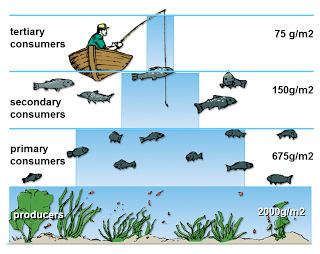How does biomass change in different trophic levels?
1 Answer
In terrestrial systems, biomass decreases as trophic level increases. Aquatic systems follow a slightly different trend but read the full explanation.
Explanation:
Biomass refers to the amount of living organisms in a particular area in regards to their mass (not the number of individuals). In terrestrial systems, biomass decreases as trophic level increases. A pyramid of biomass illustrates this concept:
 https://sites.google.com/a/ssccards.org/nuvia-ecology/13-6-pyramid-models
https://sites.google.com/a/ssccards.org/nuvia-ecology/13-6-pyramid-models
This trend becomes a little bit more complicated when we look at aquatic systems. Energy is always lost as we climb to higher trophic levels (only 10% is available for the next trophic level to use). This is true whether we are considering terrestrial or aquatic systems.
Yet, when biomass is measured or estimated, it is measured or estimated at an exact moment of time. Doing so fails to consider the rate at which energy moves through the system; the reproductive potential of each trophic level and the amount of time it takes for organisms in that trophic level to grow. This can result in an inverted pyramid of biomass.
http://www.arctic.uoguelph.ca/cpl/organisms/plants/biology/web4.htm
Aquatic primary producers, phytoplankton, reproduce very quickly but they are are also consumed very quickly. So, at any one period of time, there biomass of phytoplankton will be lower than its consumers.
However, if you were to look at the amount of biomass produced over a longer period of time, such as a few months or a whole year, the phytoplankton would have a greater biomass than their consumers. The high rate at which the phytoplankton is consumed is matched by its high rate of production. At any one time, it looks like this trophic level is smaller than the one above it, like in the image above, but the cumulative biomass is in fact greater.

